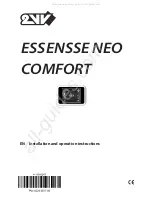
10
7.0.
MAINTENANCE
To ensure maximum life of the equipment, the following
should be part of an
annual
maintenance program.
Warning
De-energize unit before performing maintenance.
Voltages are present inside this unit which can
cause injury. Therefore, only personnel qualified to
service electrical equipment should perform
maintenance on this unit.
7.1.
Vacuum the voltage regulator inside and out to
remove accumulated dirt, which could lead to
overheating or insulation failure.
7.2.
Tighten all electrical connections, particularly all
power wiring to, and in, the unit.
7.3.
Inspect all variable transformer brushes and
commutators for signs of wear or pitting. Replace as
required. See diagram below.
Do not attempt to clean a commutator with an
abrasive such as sandpaper or a file.
This will ruin
the soft precious metal plating on the commutator and
will shorten the life of the unit. It is normal for
commutators to become black due to carbon brush
tracking. If a commutator is to be cleaned, use
denatured alcohol and a soft cloth.
7.4.
Inspect the variable transformer drive belts,
sprockets, gears, cams, etc. for signs of slippage or
wear and adjust as required.
7.5.
Check the variable transformer radiator(s) (the
die cast part that holds the brush assembly) for signs of
slippage, and see if all brushes driven by the same
motor are aligned with each other. The alignment of the
radiator and brushes depends on the setscrews that
hold the variable transformer center tube(s) to the shaft
and the setscrews that hold the radiator to the center
tube. Adjust and tighten as needed.
7.6.
Lubrication of the WHR Series voltage regulator
is not required since it has been lubricated at the factory
for its lifetime.
8.0.
TROUBLESHOOTING
WHR Series voltage regulators will provide long,
reliable service with little attention. Unless the unit is
overloaded, there is little likelihood of component
failure.
Warning
Voltages are present inside this unit which can
cause injury. Therefore, only personnel qualified to
service electrical equipment should perform
trouble-shooting procedures on this unit.
If the regulator fails to operate correctly, the following
checks will help locate and correct the problem. Refer
to the schematic, rating chart and replacement parts list
for further information.
8.1.
Check the load connected to the voltage
regulator to be sure the unit's output current rating is not
being exceeded.
8.2.
See if the POWER pilot lamps are on. If a lamp is
not on, there is no power to the voltage regulator, or
control module fuses F1 and F2 (POWER fuses) are
blown, or the lamp has burned out. Check the POWER
fuses (F1 and F2). Check the power input to the unit to
be sure the voltage is within the range specified for the
selected output voltage.
8.3.
Check the output voltmeters. If a meter shows
zero output voltage, check the input line, control module
fuses F3 and F4 (CONTROL fuses), remote sense
wiring if applicable, and input connections. If so
equipped, check position of input circuit breaker and
manual bypass switch.
8.4.
Check the CONTROL pilot lamps. If one is not lit,
check it's VOLTAGE RANGE switch to be sure it is on
and check for blown CONTROL fuses (F3 and F4). If
applicable, check the remote sense wiring.
8.5.
If the motor hunts (cycles continuously), readjust
the SENSITIVITY control.
8.6.
If a motor drives a POWERSTAT variable
transformer to one end of its travel, and the voltage
decreases when it should increase or increases when it
should decrease, check to see if the input and output
power connections to the voltage regulator are
reversed. If applicable, check the remote sense wiring.
8.7.
If the unit has been reworked or repaired, check
to see if the leads driving the motor have been
reversed. A1-TB1-2 and A1-TB1-3 provide the motor
power to lower and raise the motor with A1-TB1-1 being
the common for both AC voltages.
Summary of Contents for STABILINE WHR32 Series
Page 2: ...2...
Page 16: ...16 11 0 SCHEMATIC For reference only use full size supplied with unit...
Page 18: ...18 Enclosures A through G continues Note All dimensions are inches millimeters...
Page 19: ...19 Enclosures A through G continues Note All dimensions are inches millimeters...
Page 20: ...20 Enclosures DPLUS through GPLUS Note All dimensions are inches millimeters...
Page 21: ...21 Enclosures DPLUS through GPLUS continues Note All dimensions are inches millimeters...
Page 22: ...22 Enclosures DD through GG Note All dimensions are inches millimeters...
Page 23: ...23 Enclosures DD through GG continues Note All dimensions are inches millimeters...
Page 24: ...24 Enclosures EEE through GGG Note All dimensions are inches millimeters...
Page 25: ...25 Enclosures EEE through GGG continues Note All dimensions are inches millimeters...











































